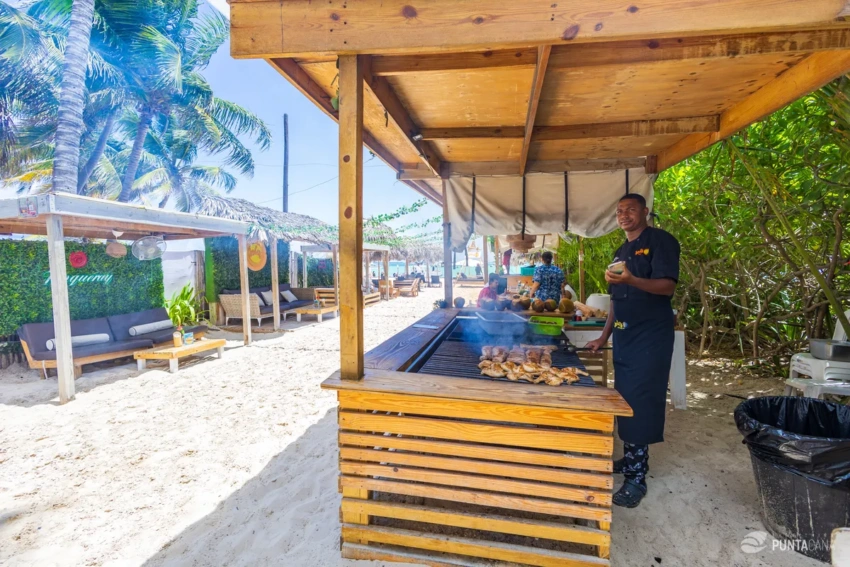A Foodie’s Tour: Dominican Cuisine and Local Markets
Introduction to Dominican Cuisine

A Foodie’s Tour: Dominican Cuisine and Local Markets
Welcome to the tantalizing world of Dominican cuisine, where every bite is a celebration of the island’s rich cultural tapestry. The Dominican Republic’s culinary landscape is a vibrant blend of flavors and traditions, reflecting its diverse history and cultural influences.
1. A Melting Pot of Flavors
Dominican food is like a delightful symphony, harmonizing ingredients and techniques from the island’s indigenous people, the Taino, with those brought by African and Spanish settlers. This fusion has resulted in a cuisine that’s both unique and deeply rooted in its heritage. African influences can be seen in the use of root vegetables and plantains, which are often used to create hearty, flavorful dishes. Spanish colonization introduced new spices, meats, and culinary techniques, enriching the Dominican food palette. The Taino legacy is evident in the use of indigenous ingredients like cassava and corn. Together, these influences create a culinary dance that is distinctly Dominican.
2. Staple Ingredients in Dominican Cooking
At the heart of Dominican cuisine are a few staple ingredients that form the foundation of many beloved dishes. Plantains, rice, beans, and fresh seafood are the stars of the show. Plantains are incredibly versatile, appearing in dishes like mangú, a breakfast favorite made from mashed plantains, and tostones, twice-fried plantains often served as a savory side dish. Rice and beans are ubiquitous, typically served together as a comforting staple known as la bandera, symbolizing the Dominican flag with its vibrant colors. The abundance of fresh seafood reflects the island’s geographical bounty, making dishes like grilled fish and seafood stews a central part of the diet.
3. Traditional Cooking Techniques
Dominican kitchens are a testament to the art of traditional cooking methods. Slow-cooking is a cherished technique, allowing flavors to meld and deepen over time. This method is particularly important for dishes like sancocho, a hearty stew that combines meats, root vegetables, and spices into a soul-warming meal. Another hallmark of Dominican cooking is the use of calderos, or clay pots. These pots are prized for their ability to evenly distribute heat and impart a unique flavor to the food. Cooking in a caldero is an experience in itself, connecting modern-day cooks with generations of culinary tradition.
Embark on this flavorful journey and let the tastes of the Dominican Republic whisk you away to a world of culinary wonder. With each dish, you’ll discover the rich stories and vibrant cultures that make this cuisine truly unforgettable.
Signature Dominican Dishes

Punta Cana
Dominican cuisine is a vibrant tapestry woven with rich flavors and heartwarming dishes that capture the essence of the Caribbean. If you’re an adventurous foodie, prepare to dive into a world of culinary delights that will leave your taste buds dancing with joy!
1. Sancocho: A Hearty Stew
Sancocho is the soul of Dominican comfort food—a hearty stew that’s a celebration of ingredients and tradition. Imagine a simmering pot filled with a mix of meats such as chicken, beef, and pork, combined with an assortment of tubers like yucca, sweet potatoes, and plantains. It’s a dish that embodies the essence of family gatherings and festive occasions.
The preparation of sancocho is an art in itself, with each region adding its own twist. The addition of corn, cilantro, and a splash of lime elevates the flavors, giving it a distinct taste that is both nourishing and flavorful. Traditionally slow-cooked over a low flame, the stew allows the flavors to meld beautifully, creating a dish that warms the heart as much as the stomach.
2. Mangu and its Variations
Start your day the Dominican way with mangu, a beloved breakfast dish that’s as versatile as it is delicious. Made from mashed plantains, mangu is the ultimate comfort food. It’s typically served with sautéed red onions, fried eggs, and a side of salami or cheese—known affectionately as “Los Tres Golpes.”
Mangu’s beauty lies in its simplicity, yet it offers endless possibilities for variations. Some variations incorporate garlic or butter for added richness, while others might feature a tropical twist with a hint of avocado. It’s a dish that invites creativity and personal touch, making it a staple on Dominican breakfast tables.
3. La Bandera Dominicana: The National Dish
La Bandera Dominicana, or “The Dominican Flag,” is more than just a meal—it’s a national symbol. This dish is a harmonious trio of rice, beans, and meat, typically accompanied by a side salad or tostones (fried plantains). The name “La Bandera” reflects the Dominican Republic’s flag, and the dish is a daily staple for many families.
Each component of La Bandera is prepared with care: the rice is often seasoned with herbs and spices, the beans are cooked to perfection with garlic and oregano, and the meat—whether it’s chicken, beef, or pork—is marinated and cooked with a variety of spices. The result is a plate that’s not only delicious but also a reflection of Dominican identity and hospitality.
Our Best Tours in Punta Cana
As you savor these signature dishes, why not complement your culinary adventure with an exciting tour in Punta Cana? Explore the beautiful landscapes and vibrant culture of the Dominican Republic with our specially curated excursions. Dive into the local life and experience the true essence of this Caribbean paradise.

Saona Island Excursion - Caribbean Paradise
from $75 Read more
Swimming with Dolphins in Punta Cana - Top Adventure 2025 (50 minutes)
from $149 Read moreExploring Local Markets
Dive into the bustling heart of the Dominican Republic by exploring its vibrant local markets. These markets are not just places to buy fresh produce; they are the pulse of Dominican culture, where you can truly taste, smell, and feel the essence of the island.
1. Top Markets to Visit
The Dominican Republic is home to several bustling markets, each offering a unique slice of life and a cornucopia of flavors. Mercado Modelo in Santo Domingo is a must-visit. Known for its lively atmosphere, this market is a hub for everything from handmade crafts to aromatic spices. Wander through the stalls and let your senses be captivated by the vibrant colors and rich aromas.
In Santiago, Mercado Central is the place to be. This market is famed for its extensive selection of fresh produce and seafood, directly sourced from the surrounding fertile lands and coastal waters. It’s a fantastic spot to observe the daily life of locals and perhaps even pick up a few culinary tips from the seasoned vendors.
2. Seasonal Produce and Fresh Finds
One of the delights of exploring Dominican markets is the abundance of seasonal produce. The tropical climate allows for a diverse range of fruits and vegetables all year round. From juicy mangoes and sweet papayas to exotic guanabanas, each season brings its own bounty. Seafood lovers will find themselves in paradise with a selection of fresh catches including snapper, grouper, and the much-loved shellfish.
Available Seasonal Produce and Seafood
| Season | Fruits | Vegetables | Seafood |
|---|---|---|---|
| Spring | Mangoes, Avocados | Peppers, Eggplant | Snapper, Shrimp |
| Summer | Papayas, Pineapples | Okra, Squash | Grouper, Lobster |
| Fall | Bananas, Guanabanas | Yuca, Plantains | Shellfish, Tuna |
| Winter | Oranges, Passionfruit | Carrots, Cabbage | Mahi-mahi, Clams |
Being aware of what’s in season not only ensures that you enjoy the freshest flavors but also supports the local economy and farmers who work tirelessly to bring these goods to market.
3. Tips for Navigating the Markets
For first-time visitors, Dominican markets can be overwhelming yet exhilarating. Here are some practical tips to make your experience both enjoyable and fruitful:
- Start Early: Arrive early in the morning to catch the best selection of products and avoid the heat of the midday sun.
- Bargain Boldly: Haggling is part of the culture, so don’t be shy to negotiate prices. It’s all part of the fun!
- Bring Cash: While some vendors may accept cards, cash is king in these markets. Ensure you have small denominations for easier transactions.
- Taste Before You Buy: Vendors often offer samples, so take advantage of this to try before you buy. It’s a great way to discover new flavors.
- Respect the Culture: Engage with vendors and learn about the products. Respect local customs and you’ll find your experience enriched.
The markets of the Dominican Republic are a treasure trove of culinary delights and cultural experiences. Whether you’re a foodie on the hunt for exotic ingredients or a curious traveler looking to immerse yourself in local life, these markets offer something for everyone. So grab your shopping bags and embark on a sensory journey through the heart of Dominican cuisine!
Dominican Street Food Delights

Punta Cana
Embark on a tantalizing journey through the bustling streets of the Dominican Republic, where the air is filled with the irresistible aroma of sizzling street food. The vibrant street food scene is a testament to the country’s rich cultural tapestry, offering a medley of flavors that captures the essence of Dominican life.
1. Chimichurri: The Dominican Burger
Chimichurri, affectionately known as “chimi”, is a culinary gem that transforms the humble burger into a Dominican street food icon. Unlike its international counterparts, the chimi is characterized by its unique combination of flavors and textures. A typical chimi features a seasoned beef patty, topped with cabbage, tomatoes, and a generous drizzle of a tangy, creamy sauce, all sandwiched between crusty bread. The secret to its popularity? The irresistible combination of garlic and oregano-infused beef that makes each bite a savory delight.
For an authentic experience, you must visit the late-night food stalls that line the streets of Santo Domingo and Santiago. These bustling spots come alive after dark, turning into vibrant hotspots where locals and tourists alike gather for a quick, satisfying meal. Whether you’re a night owl or a food enthusiast, a chimi is an essential part of the Dominican street food experience.
2. Empanadas: A Crunchy Snack
Empanadas in the Dominican Republic are more than just a snack—they are a delightful culinary tradition. These golden pastries, either fried or baked, are filled with a variety of delicious ingredients such as beef, chicken, cheese, or even seafood. Their flaky exterior and flavorful fillings make them a beloved treat for any time of the day.
The beauty of the Dominican empanada lies in its versatility. Whether you’re grabbing a quick breakfast or enjoying an afternoon snack, these pastries are easily accessible from street vendors and bakeries across the country. The aroma of freshly made empanadas wafting through the air is simply irresistible. Pair them with a spicy dipping sauce for an extra kick, and you have a snack that’s hard to beat.
3. Tostones and Mofongo: Plantain Perfection
Plantains are a staple in Dominican cuisine, and their versatility shines in dishes like tostones and mofongo. Tostones are twice-fried plantain slices, crispy on the outside and tender on the inside, often served with a garlic dipping sauce that enhances their savory flavor. Whether as a side dish or a standalone snack, tostones are a must-try for anyone exploring Dominican street food.
Mofongo, on the other hand, elevates plantains to a whole new level. Mashed with garlic, olive oil, and chicharrón (fried pork cracklings), this dish offers a rich, savory profile that’s simply unforgettable. Often served with a hearty broth or as an accompaniment to meat dishes, mofongo is a staple at street-side eateries and upscale restaurants alike.
Discover Our Top Street Food Tours
Indulge your taste buds with our exclusive street food tours that take you on a flavorful journey through the heart of the Dominican Republic. Explore bustling markets, meet local vendors, and savor the authentic flavors that define Dominican street food culture.

Punta Cana Private Boat Trip at the Best Price - 3-Hour Exclusive Tour with Snorkeling (from Jellyfish to Cabeza de Toro)
from $590 Read more
Power Cruise – Punta Cana Party Experience on the Bad Girl Catamaran
from $65 Read moreThe Role of Music and Dance in Dominican Food Culture
Picture this: a vibrant Dominican restaurant, the aroma of sizzling spices in the air, as the lively beats of merengue and bachata fill the room, inviting diners to sway to the rhythm. Music and dance are not just entertainment; they are essential threads woven into the fabric of Dominican food culture, creating an immersive and unforgettable dining experience.
1. Merengue and Bachata: The Soundtrack to Meals
In the Dominican Republic, meals are not just about food; they’re a celebration of life, love, and community. This celebration is incomplete without the energizing beats of merengue and the soulful rhythms of bachata, which provide the perfect backdrop to any meal.
Merengue, with its quick-paced tempo and lively melodies, sets the stage for joyous gatherings, often encouraging diners to take a break from their meals and dance. This music style, which originated in the Dominican Republic, is more than just a form of entertainment—it’s a cultural emblem. Whether dining at a local ‘comedor’ or a high-end restaurant, the infectious beats of merengue create an atmosphere of celebration and camaraderie.
Bachata, on the other hand, offers a more romantic and introspective experience, often accompanying intimate dinners or late-night meals. With its roots deeply embedded in Dominican soil, bachata’s heartfelt lyrics and gentle rhythms resonate with the emotional essence of Dominican life. Together, these musical styles add a dynamic layer to the dining experience, making each meal feel like a festive occasion.
2. Festivals and Food: Celebrations of Culture
The Dominican calendar is peppered with vibrant festivals where food takes center stage alongside music and dance. These cultural celebrations offer a feast for the senses, where the culinary delights are as varied and colorful as the festivities themselves.
One such festival is the Carnaval Dominicano, a lively event celebrated throughout February, where the streets come alive with parades, costumes, and, of course, a bounty of traditional foods. Vendors line the streets offering an array of dishes, from succulent roasted pork to flavorful empanadas. The intoxicating mix of music, dance, and food creates a joyous atmosphere, inviting everyone to indulge in the festivities.
Similarly, the Dominican Day of Independence on February 27th is marked by grand celebrations, where food plays a pivotal role. Families and friends gather to enjoy a festive meal while the rhythms of merengue and bachata fill the air, embodying the spirit of freedom and unity.
3. Dining Etiquette and Social Gatherings
Dining in the Dominican Republic is a communal affair, where social interactions are as important as the food itself. Understanding the local dining etiquette and customs enhances the experience, allowing visitors to fully immerse themselves in the culture.
Dominican dining etiquette emphasizes hospitality and warmth. Upon entering a home or restaurant, a friendly greeting and a warm smile set the tone for the meal. It’s common for meals to be shared family-style, encouraging conversation and interaction. The use of “buen provecho,” meaning “enjoy your meal,” is a customary phrase that reflects the communal spirit of Dominican dining.
Social gatherings often involve lively discussions, laughter, and sometimes spontaneous dances, further enriched by the presence of music. Whether at a casual family dinner or a formal event, the emphasis is on enjoying the company of others, making every meal a memorable social experience.
Frequently Asked Questions
What are some must-try dishes in Dominican cuisine?
Some must-try dishes in Dominican cuisine include La Bandera (a traditional meal consisting of rice, beans, and meat), Mangu (mashed plantains), and Sancocho (a hearty stew made with various meats and root vegetables). These dishes offer an authentic taste of Dominican culture and flavors.
Where can I find local markets in the Dominican Republic?
Local markets can be found in most towns and cities across the Dominican Republic. Some popular ones include Mercado Modelo in Santo Domingo, Mercado Nuevo in Santiago, and La Vega Market. These markets offer a wide range of fresh produce, spices, and local specialties.
What should I expect when visiting a Dominican market?
When visiting a Dominican market, expect a vibrant and bustling atmosphere. You’ll find a variety of vendors selling fresh fruits, vegetables, meats, and seafood. Be prepared to haggle for prices, as bargaining is common practice. It’s also a great opportunity to interact with locals and learn more about their food culture.
Are Dominican markets safe to visit for tourists?
Most Dominican markets are safe for tourists; however, it’s always important to stay aware of your surroundings and keep an eye on your belongings. Visiting during daylight hours and going with a local guide or group can enhance your safety and experience.
Can I find vegetarian or vegan options in Dominican cuisine?
Yes, there are vegetarian and vegan options in Dominican cuisine. Dishes like Mangu (mashed plantains) and Moro de Habichuelas (rice and beans) can be enjoyed without meat. Many local markets also offer a wide variety of fresh fruits and vegetables that cater to a plant-based diet.
What are some typical ingredients used in Dominican cooking?
Typical ingredients in Dominican cooking include plantains, yuca, rice, beans, cilantro, and coconut. These ingredients are staples in many traditional dishes and contribute to the rich and diverse flavors of Dominican cuisine.
Is it necessary to speak Spanish when visiting Dominican markets?
While knowing Spanish can enhance your experience, it is not absolutely necessary. Many vendors may speak basic English, especially in tourist areas. However, learning a few key phrases in Spanish can be helpful and is appreciated by locals.
How can I ensure I'm getting authentic Dominican food while touring?
To ensure you’re getting authentic Dominican food, look for restaurants frequented by locals rather than those mainly catering to tourists. Visiting family-owned eateries and asking locals for recommendations can also lead you to genuine culinary experiences.
What is the best time of year to visit Dominican markets?
Dominican markets are open year-round, but the best time to visit depends on your preference for weather conditions. The dry season, from December to April, offers pleasant weather for exploring markets. Keep in mind that this is also the peak tourist season, so markets may be busier during these months.
